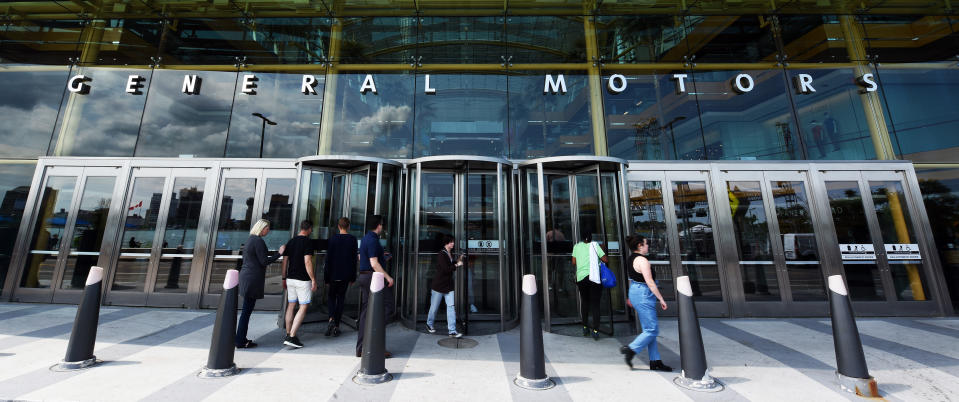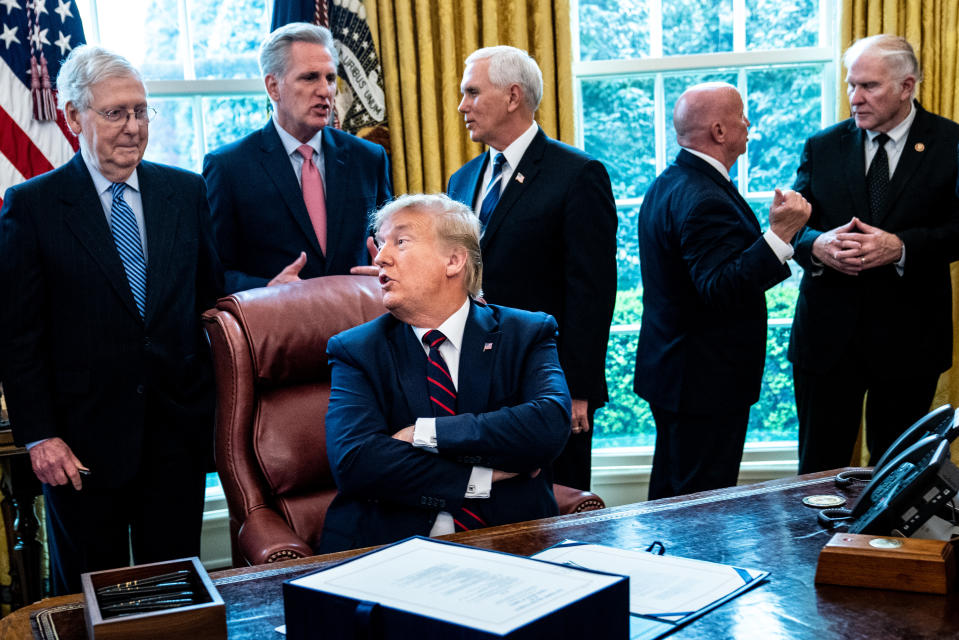In reversal, Trump uses Defense Production Act to force GM to make ventilators
WASHINGTON — President Trump on Friday ended nine days of equivocating over whether to deploy the Defense Production Act, announcing that he would use his presidential powers under the legislation to compel General Motors to produce ventilators for the U.S. medical system.
The White House released a statement by Trump saying he had signed a memorandum instructing the Department of Health and Human Services to “use any and all authority available under the Defense Production Act to require General Motors to accept, perform, and prioritize Federal contracts for ventilators.”
In invoking the act, Trump blamed GM for the delays.
“Our negotiations with GM regarding its ability to supply ventilators have been productive, but our fight against the virus is too urgent to allow the give-and-take of the contracting process to continue to run its normal course,” Trump said. “GM was wasting time. Today’s action will help ensure the quick production of ventilators that will save American lives.”
In a statement published on its website, GM affirmed its ability to meet the demand: “Depending on the needs of the federal government, Ventec and GM are poised to deliver the first ventilators next month and ramp up to a manufacturing capacity of more than 10,000 critical care ventilators per month with the infrastructure and capability to scale further.”
Less than 24 hours earlier, Trump had downplayed the need for the crucial medical equipment, which is used to help the most ill patients suffering from respiratory failure due to the coronavirus. Appearing on Fox News Thursday night, the president dismissed calls by New York Gov. Andrew Cuomo for his state to receive 30,000 more ventilators on top of the 7,000 or so they currently have.
“I don’t believe you need 40,000 or 30,000 ventilators,” Trump said. “You go into major hospitals sometimes, and they’ll have two ventilators. And now, all of a sudden, they’re saying, Can we order 30,000 ventilators?”

By Friday morning, Trump’s tone had changed. A little less than an hour before noon he tweeted that General Motors “said they were going to give us 40,000 much needed Ventilators, ‘very quickly’. Now they are saying it will only be 6,000, in late April, and they want top dollar.”
The president threw in a few personal digs at GM CEO Mary Barra, and added in another tweet, “General Motors MUST immediately open their stupidly abandoned Lordstown plant in Ohio, or some other plant, and START MAKING VENTILATORS, NOW!!!!!!”
Trump added in another auto company that has expressed interest in making ventilators. “FORD, GET GOING ON VENTILATORS, FAST!!!!!!” he wrote.
It was a head-spinning reversal by the president from his statements the evening before, and came after more than a week of confusing and contradictory statements by Trump about his intention to use the Cold War-era legislation.
The Defense Production Act, or DPA, allows the president to compel private industries to produce products deemed necessary for the nation’s defense.
Officials at HHS were reported to be thinking about using the act as early as late February, a month ago. But at that time, Trump was downplaying the risk of the virus, which set the tone for the rest of the government.
“Because of all we’ve done, the risk to the American people remains very low,” Trump said on Feb. 27. He promised that the 15 cases in the U.S. “within a couple of days is going to be down to close to zero.”

The number of cases in the U.S. on Friday afternoon had reached 99,706, and at least 1,554 Americans had died of the disease.
Trump first said he had invoked the DPA on March 18: “We have targets for certain pieces of equipment. We’ve ordered millions of masks, but we need millions more. We need ventilators.”
But he quickly began making statements indicating a reticence to actually use the powers available to him under the act. A day later he tweeted that he only planned to use the DPA “in a worst case scenario in the future.”
“Hopefully there will be no need,” he said.
On March 20, Trump said he was using the DPA. “We are using it … for certain things that we need,” Trump said under questioning from reporters at the White House. “I wouldn’t say ventilators. Probably more masks.”
Two days after that, Trump and HHS Secretary Alex Azar said they didn’t need to use the DPA after all. Trump explained that when he said he was “using” the act, he really just meant he had activated it.
“Well, we are using it now. The fact that I signed it, it’s in effect,” Trump told reporters.
It appeared that Trump’s ideological opposition to government intervention in the free market was behind much of the delay in using the DPA.
“But, you know, we’re a country not based on nationalizing our business. Call a person over in Venezuela; ask them how did nationalization of their businesses work out. Not too well. The concept of nationalizing our business is not a good concept,” Trump said.
Azar added: “What we’ve seen with this outpouring of volunteers from private enterprise: We’re getting what we need without putting the heavy hand of government down.”

But Trump added another wrinkle on Friday, telling reporters that he had essentially threatened companies that he might use the DPA against them multiple times, but had relented after they agreed to produce medical supplies. “We pulled it back three times because the companies came through in the end and we did not need the act. It has been great leverage,” he said.
On March 24, the head of the Federal Emergency Management Agency, Peter Gaynor, told CNN that the Trump administration would “use the DPA for the first time” to obtain 60,000 coronavirus test kits.
Later that day, a FEMA spokesperson added yet another reversal to the ongoing saga. “At the last minute, we were able to procure the test kits from the private market without invoking the DPA,” said FEMA spokeswoman Lizzie Litzow.
On Thursday night, the New York Times reported that FEMA had been close to announcing a partnership between General Motors and Ventec Life Systems to produce many new ventilators, but had balked at a price tag of up to $1 billion. And there were questions about how many ventilators that partnership might actually produce, with promises of up to 80,000 machines shrinking down to only about 7,500.
In the White House statement late Friday, Trump did not say how many ventilators the government had ordered from General Motors.
But while talking to reporters in the Oval Office after he had signed a $2.2 trillion rescue package passed by Congress earlier in the day, Trump said General Motors had eventually only been able to deliver 6,000.
“We thought we had a deal for 40,000 ventilators and all of a sudden 40,000 came down to 6,000. And then they talked about a higher price than we were discussing. So I didn’t like it,” he said.
And even then, he added yet one more equivocation.
“We did activate it with respect to General Motors,” he said. “Hopefully, we won’t need the full activation.”
_____
Read more from Yahoo News:



